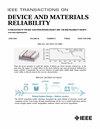Statistical Model and Transistor Size Effect of Hot Carrier Injection for Stability Reinforced SRAM Physically Unclonable Function
IF 2.3
3区 工程技术
Q2 ENGINEERING, ELECTRICAL & ELECTRONIC
IEEE Transactions on Device and Materials Reliability
Pub Date : 2025-03-29
DOI:10.1109/TDMR.2025.3574796
引用次数: 0
Abstract
Hot carrier injection (HCI) has been strategically leveraged to enhance the stability of SRAM physically unclonable functions (PUFs). Since the effects of HCI are not constant, exhibiting cell-to-cell variability, a comprehensive distribution model is essential to harness HCI effectively. This article presents a statistical distribution model of mismatch after HCI burn-in and examines the impact of transistor size of PUF on the distribution shape, yielding enhanced stability and shorter HCI burn-in time. The proposed mismatch model after HCI burn-in integrates the native distribution with a Poisson distribution for number of captured electrons and a Gamma distribution for the effect of captured electrons. Model calculations based on size effects reveal that over three times reduction in HCI burn-in duration by enhancing the size to quadruple times: a 15-min for quadruple-size transistor SRAM PUF compared to 46-min for single-size PUF. The model is confirmed by the real chip measurement. The PUFs with several sized transistors are fabricated in a 130-nm standard CMOS process. Experimental results show that quadruple-size transistor SRAM PUF reaches 1.82E−09 unstable cell ratio after 18-min HCI burn-in, which align with the model based expectation. Furthermore, robust stability is exhibited even the worst VT corner (0.6V /稳定性增强SRAM物理不可克隆功能的热载流子注入统计模型和晶体管尺寸效应
热载流子注入(HCI)已被战略性地用于提高SRAM物理不可克隆功能(puf)的稳定性。由于HCI的影响不是恒定的,表现出细胞间的可变性,因此一个全面的分布模型对于有效利用HCI至关重要。本文提出了HCI老化后失配的统计分布模型,并研究了PUF晶体管尺寸对分布形状的影响,从而提高了稳定性和缩短了HCI老化时间。提出的HCI老化后失配模型将捕获电子数的泊松分布和捕获电子效应的伽玛分布与自然分布相结合。基于尺寸效应的模型计算表明,通过将尺寸增加到四倍,HCI烧蚀时间减少了三倍以上:四尺寸晶体管SRAM PUF为15分钟,而单尺寸PUF为46分钟。该模型通过实际芯片测量得到了验证。puf具有多个尺寸的晶体管,采用130纳米标准CMOS工艺制造。实验结果表明,经过18 min HCI老化后,四倍尺寸晶体管SRAM PUF达到1.82 2e−09的不稳定电池比,符合基于模型的预期。此外,即使在最坏的VT角(0.6V / $-40^{\circ}\ maththrm {C}$),也表现出鲁棒的稳定性,显示零比特误差(BER<7.81E−08)。
本文章由计算机程序翻译,如有差异,请以英文原文为准。
求助全文
约1分钟内获得全文
求助全文
来源期刊

IEEE Transactions on Device and Materials Reliability
工程技术-工程:电子与电气
CiteScore
4.80
自引率
5.00%
发文量
71
审稿时长
6-12 weeks
期刊介绍:
The scope of the publication includes, but is not limited to Reliability of: Devices, Materials, Processes, Interfaces, Integrated Microsystems (including MEMS & Sensors), Transistors, Technology (CMOS, BiCMOS, etc.), Integrated Circuits (IC, SSI, MSI, LSI, ULSI, ELSI, etc.), Thin Film Transistor Applications. The measurement and understanding of the reliability of such entities at each phase, from the concept stage through research and development and into manufacturing scale-up, provides the overall database on the reliability of the devices, materials, processes, package and other necessities for the successful introduction of a product to market. This reliability database is the foundation for a quality product, which meets customer expectation. A product so developed has high reliability. High quality will be achieved because product weaknesses will have been found (root cause analysis) and designed out of the final product. This process of ever increasing reliability and quality will result in a superior product. In the end, reliability and quality are not one thing; but in a sense everything, which can be or has to be done to guarantee that the product successfully performs in the field under customer conditions. Our goal is to capture these advances. An additional objective is to focus cross fertilized communication in the state of the art of reliability of electronic materials and devices and provide fundamental understanding of basic phenomena that affect reliability. In addition, the publication is a forum for interdisciplinary studies on reliability. An overall goal is to provide leading edge/state of the art information, which is critically relevant to the creation of reliable products.
 求助内容:
求助内容: 应助结果提醒方式:
应助结果提醒方式:


